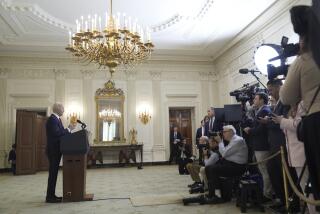Forget the police drama, tune in to a policy debate
- Share via
People who can’t get enough C-SPAN are getting more chances to watch legislative coverage from the comfort of their couches.
At a time when news media coverage of most state legislatures is increasingly sparse, there are now more than 20 stations across the country offering gavel-to-gavel legislative coverage. That’s up from a handful in the 1990s.
Only about a dozen offer full broadcast slates. Others offer limited, part-time programming.
The programming isn’t all humdrum public policy stuff: There are corruption scandals and election controversies and juicy hearings.
In Arizona, where a legislative TV system went on digital cable television in March, the regular lineup of floor sessions and committee hearings included oversight hearings into shortcomings of care at the state’s nursing home for military veterans.
Those in the fledgling industry say the coverage goes beyond sound bites to let citizens see how their state governments do the public’s business.
“What we bring to the table is a primary source for people,” said Paul Giguere, president of the National Assn. of Public Affairs Networks and founder of Connecticut’s CT-N. “This is an opportunity for people to watch for themselves and make up their own mind.”
CT-N covered Connecticut lawmakers’ inquiry into former Gov. John G. Rowland’s corruption scandal in 2004, and Deputy House Speaker Bob Godfrey said the spotlight helped push Rowland from office.
“Even before there was reality TV, this was reality TV,” Godfrey said of legislative coverage by CT-N. “This was unscripted, unrehearsed -- what’s actually going on live at the state Capitol, often on issues of interest in a general or specific way.”
On the other side of the country, Washington state’s TVW let residents watch blow-by-blow court proceedings over the close 2004 gubernatorial race.
The 2004 gubernatorial race’s coverage was the “single signature event” that told TVW that the system had a significant following, TVW President Cindy Zehnder said. “Just on the last day we had 10,000 people streaming off our website.”
In Alaska, anything to do with a proposed multimillion-dollar natural gas pipeline was big news during this year’s legislative session, said Randy Burton, producer for Gavel to Gavel Alaska.
The TV systems vary widely in organization, distribution and funding. Some are run by the state while others are independent entities, although some of those depend on state funding. Others get funding from the cable television industry, foundations, public television stations and other sources.
They may appear on cable channels or public television stations. The California Channel, which offers live coverage of Assembly and State Senate sessions, committee hearings and Sacramento news conferences, is carried by more than 130 cable systems in the state.
The various state channels have different approaches, said David Kurpius, a Louisiana State University associate dean of mass communications.
Some aim to promote public participation. Others take educational or journalistic approaches, as ratings-focused commercial television offers less political coverage, Kurpius said.
It’s meat-and-potatoes journalism, “not flashy storytelling,” Kurpius said. “They commit journalism on state government and share that around the state.”
Tim Schmaltz, a lobbyist for a consortium of Arizona groups that advocate state spending for social programs, said telecasts can be used as tutorials for activists who want to learn how to testify during hearings and for concerned citizens to track legislation.
Schmaltz, an Arizona State University adjunct faculty member, said he had already used videotaped recordings from the system for a graduate-level class he teaches on social work.
“The students loved it,” Schmaltz said. “Most of them had been down here and attended a hearing but being able to watch it and then comment on it -- the protocol, the questioning, the context -- with all of them in the room was very useful.”
More to Read
Sign up for Essential California
The most important California stories and recommendations in your inbox every morning.
You may occasionally receive promotional content from the Los Angeles Times.













